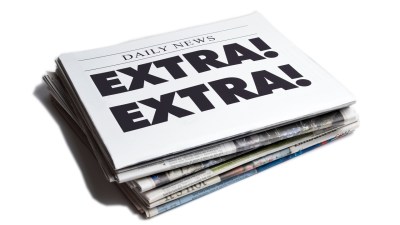Neil deGrasse Tyson, director of AMNH’s Rose Center for Air and Space, is an astrophysics rock star. How many museumers get interviewed four times by Jon Stewart? In the first interview, Jon reveals he is a “big fan” of AMNH and the Hayden Planetarium. By the second time, Jon is referred to Neil as “My liege.” (Then again, by the third interview he’s calling him &%* insane.)
Neil is a hit on Twitter as well, with (at time of posting) 99,578 followers. Thus proving that humans can be social media celebs for museums, along with other species! (We were getting a little defensive about that, Blobby and Sue.) In this interview, Neil shares his strategies for effective use of this much denigrated medium. Stay tuned over the next month for more posts on the effective use of Twitter, culminating with a CFM twebevent on Feb. 24.
I have to ask– because with some this isn’t true—do you tweet for yourself?
Oh, of course.
Skip over related stories to continue reading articleSo what’s your strategic goal for your tweeting?
That’s an interesting question. I spent nine months doubting the purpose and value of the entire social media world, but specifically tweets. Why would I waste my time telling people what I’m having for breakfast, or if I’m walking in the park now, or what a nice day it is in New York?
Then I had a kind of revelation: I was on a trip to Las Vegas filming for NOVA scienceNOW. It occurred to me that that week, a lot of things would happen in my life. First, I’d be filming. I would then be speaking to Penn and Teller about how you can fool the brain. Then later that week, I would be on Jon Stewart. So I thought, “Let me do an experiment and see what happens if I tweet my brain droppings of what goes on in the universe.”
The first time I tweeted was from the Vegas airport. I go into the bookstore—an actual bookstore with sections labeled above the bookshelves. I went to the owner and I said, “Where’s the science section?” And he said, “We don’t have a science section.” I thought that was interesting, and so I tweeted it. I forget the exact wording, because I had to fit it in 140 characters. Something like “Just landed in Vegas airport. Visited the bookstore. No science section. Wouldn’t want any critical thinking going on before you start betting on the tables.”
That tweet was an indictment of the science illiteracy of the nation and what the consequences can be. If you think you’re going to win because you can influence the probability, you’re wrong, and a background in science helps you understand how wrong you can be. Here’s a bookstore that doesn’t even have a single book in science, and it is in the Las Vegas airport.
So I started tweeting, and all of the sudden people took an interest in it, and the ranks of followers grew, at a rate of about a thousand a week. And it’s still growing at about a thousand a week. That told me that thoughts that I take for granted every day are thoughts that others thrive on.
So you see Twitter as a kind of telepathy, where you can see the world from another person’s point of view?
Well, I know that I’m granting others the opportunity to see my world through my point of view. I’m using Twitter as an educational tool, as a tool to provide scientifically informed insight into the operations of the world. Every day of my life, I have thoughts, as an educator and as a scientist, that others might be interested in.
I’ll give you another case—the earthquake in Haiti a year ago. A quarter-million people died, right? There was a lot of news and talk about this. I waited the right amount of time—it might have been six months—and I said: “Worldwide death toll from various causes in the last six months: #1: starvation, 1 million; #2: malaria, half a million; #3: car accidents, 300,000.” Last on that list was Haitian earthquake at 250,000. That was a singular event. Meanwhile, everything else is happening all the time. That was one of my earliest tweets that got heavily re-tweeted, because it put these numbers in context. We can’t yet do anything about earthquakes, but to lose a million people, mostly children, because they don’t have enough food… . The real tragedy is not the earthquake; it’s the preventable causes of death that are not prevented. I think people would rely on me as a scientist to do those numbers accurately and then present them in a new and interesting way.
I think you’ve shown that 140 characters is plenty to share insights that get people thinking. Do you pretty much tweet independently, or does the museum’s PR department exercise any editorial control?
Completely independently. But I’m not unmindful of my overall accountability as a museum representative or as a representative of science in general. So I do it with some accountability and responsibility in mind. I don’t use foul language; there’s no need to. Foul language is when you couldn’t find another word to use or didn’t know that other words could have expressed the same emotion, for example. And I tweet under my name, being aware of myself as an emerging public figure. I’m not unmindful that I’m a face of science, and so I carry some of that accountability with me. It doesn’t mean that I’m politically correct. I’ll say something sharp if it has to be said. And if it ticks off a couple of people, that doesn’t bother me—whereas a museum might be a little more tepid about that.
Any other advice for our readers?
Museums that don’t track the role and value of social media going forward, just either because of traditions against it or because they think it’s just a fad, do so at the peril of their own budget and their own annual attendance.
These remarks are taken from a longer interview I conducted with Dr. Tyson—stay tuned for his thoughts on the educational role of museums, and how museums can shape the future, in the May/June issue of Museum. Want to hear Dr. Tyson in person? Join us for his keynote address at the AAM annual meeting in Houston, May 22-25!









Comments